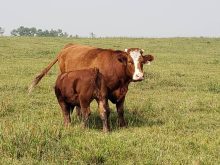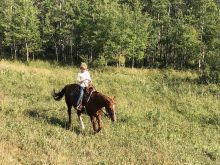Despite recent rain/snows, prolonged dry conditions this summer have left a wake of poor grazing pastures across the Prairies. High-fibre (aka low-energy) and low-protein grass has been the norm as well as a very poor mineral profile.
A well-balanced autumn/winter mineral (and vitamin) program is necessary for gestating beef cows and replacement heifers in order to build up their mineral (and vitamin) status for not only the next few months, but onto the calving season and looking ahead to the next year’s breeding season.
Read Also

Harvest wraps up and fall work begins
At the Eppich famly ranch in western Saskatchewan, the fall harvest was successful with few breakdowns, cows and calves have been sorted and a new tractor has arrived
Use a well-balanced mineral feeding program that exceeds the current gestating beef cow’s basic mineral and vitamin nutrient requirements. This action helps meet all biological functions that may come together now and months away in order to get cows successfully rebred. Here are a few reasons why minerals are so important:
- Promote cellular and tissue health — Copper, zinc, manganese and selenium are essential for activating enzyme systems that act as antioxidants and prevent oxidative stress. It helps to improve reproductive performance — cows readily clean after calving with a quick return to estrus.
- Promote growth — A good mineral program is involved in good feed intake, its better digestibility and good feed conversion.
- Enhance immunity — Many trace minerals are also involved in enzyme systems that drive immune function against disease. When beef cow and their calves are trace mineral deficient, there is decreased immunity at the cellular level, lower antibody response against disease as well as a longer recovery back to good health. For example, copper levels in tissue parallel disease-fighting white blood cell levels in cattle.
- Promote reproduction — By feeding more biological available organic/chelated trace minerals. It has been demonstrated to: (i) improve conception rates, (ii) confirm pregnancies in replacement heifers earlier and (iii) triple healthy ova shed by mature cows and heifers during estrus. For example, manganese is essential for the follicular development on the ovary. A marginal deficiency of manganese will not allow development to proceed and anestrus or silent heat results.
Backed by research
One of best university-driven examples of increasing good pre-calving trace-mineral status and mapping its value in fertile beef cows was demonstrated in a recent West Coast study (2016). Researchers sorted out 84 pre-calving beef cows with adequate trace mineral status into three treatment groups; no trace mineral supplementation, an inorganic supplement group and a group fed more bioavailable “chelated/organic” copper, manganese, zinc and cobalt. These three experimental diets were fed through the third trimester until calving.
The trial showed despite the two-supplemental trace mineral groups having improved mineral status and much of this status being transferred to their unborn calf, the chelated product produced the better results. Weaning weights averaged 519 pounds for calves from cows receiving the chelated/organic minerals versus 491 pounds for those from the group receiving the inorganic minerals only.
A good fall/winter mineral should contain high fortified-chelated (organic) levels of copper, zinc, manganese and seleno-yeast as well as elevated levels of vitamins A, D and E. It also should contain a B-vitamin complex. In the latter, that’s because with dried-out pasture and general cattle stress the rumen bugs produce inadequate levels of B vitamins and supplementation is likely necessary.
As a beef nutritionist, I again advocate a “breeder-type” cattle mineral for this year’s poor pasture situations. I also target a daily consumption of three to four ounces per head. On occasion, I recommend that producers calculate the average mineral intake of the herd, and make the necessary adjustment for adequate and consistent mineral consumption.
In summary, beef producers should feed a well-balance and breeder-type mineral, because in this way:
- Mineral requirements of brood cows and replacement heifers are met, which double at calving time and double again during the breeding season are met.
- Promote the integrity of the next follicular cycle, which is initiated 100 days before the upcoming calving season and taken through to active post-partum estrus cycles and conception.
- Take advantage of special mineral properties such as specific trace minerals, which are associated with lean muscle deposition in growing replacement cattle and other cattle.
- Enhance immune function, which promotes natural antibody response to disease and recovery back to health. This includes effective vaccination programs as well as reduction in medication during treatment.















